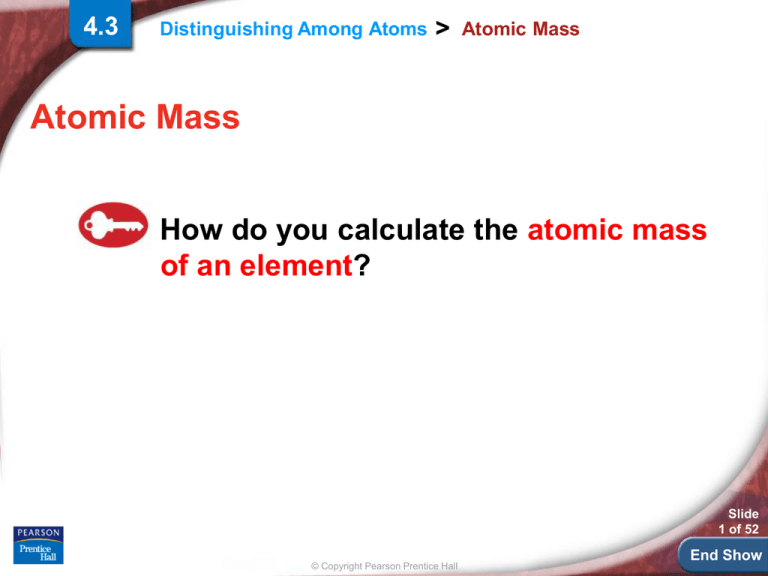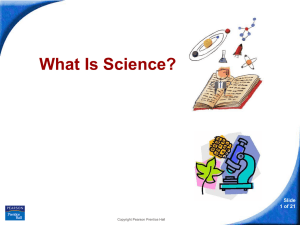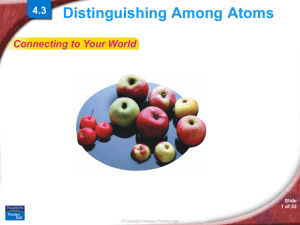
4.3
Distinguishing Among Atoms
>
Atomic Mass
Atomic Mass
How do you calculate the atomic mass
of an element?
Slide
1 of 52
© Copyright Pearson Prentice Hall
End Show
4.3
Distinguishing Among Atoms
>
Atomic Mass
It is useful to to compare the relative masses of
atoms to a standard reference isotope. Carbon12 is the standard reference isotope. Cabon-12
has a mass of exactly 12 atomic mass units.
An atomic mass unit (amu) is defined as one
twelfth of the mass of a carbon-12 atom.
Slide
2 of 52
© Copyright Pearson Prentice Hall
End Show
4.3
Distinguishing Among Atoms
>
Atomic Mass
Some Elements and Their Isotopes
Slide
3 of 52
© Copyright Pearson Prentice Hall
End Show
4.3
Distinguishing Among Atoms
>
Atomic Mass
The atomic mass of an element is a weighted
average mass of the atoms in a naturally
occurring sample of the element.
A weighted average mass reflects both the mass
and the relative abundance of the isotopes as
they occur in nature.
Slide
4 of 52
© Copyright Pearson Prentice Hall
End Show
Slide
5 of 52
© Copyright Pearson Prentice Hall
End Show
Practice Problems for Conceptual Problem 4.3
for Conceptual Problem 4.3
Slide
6 of 52
© Copyright Pearson Prentice Hall
End Show
4.3
Distinguishing Among Atoms
>
Atomic Mass
To calculate the atomic mass of an element, multiply the
mass of each isotope by its natural abundance, expressed
as a decimal, and then add the products.
For example, carbon has two stable isotopes:
• Carbon-12, which has a natural abundance of
98.89%, and
• Carbon-13, which has a natural abundance of
1.11%.
Slide
7 of 52
© Copyright Pearson Prentice Hall
End Show
SAMPLE PROBLEM 4.2
Slide
8 of 52
© Copyright Pearson Prentice Hall
End Show
SAMPLE PROBLEM 4.2
Slide
9 of 52
© Copyright Pearson Prentice Hall
End Show
SAMPLE PROBLEM 4.2
Slide
10 of 52
© Copyright Pearson Prentice Hall
End Show
Practice Problems for Sample Problem 4.2
Slide
11 of 52
© Copyright Pearson Prentice Hall
End Show
4.3
Distinguishing Among Atoms
>
The Periodic Table—A Preview
The Periodic Table—A Preview
Why is a periodic table useful?
A periodic table is an arrangement of elements
in which the elements are separated into groups
based on a set of repeating properties.
A periodic table allows you to easily
compare the properties of one element
(or a group of elements) to another
Slide
12 of 52
element (or group of elements).
© Copyright Pearson Prentice Hall
End Show
4.3
Distinguishing Among Atoms
>
The Periodic Table—A Preview
The Periodic Table
Slide
13 of 52
© Copyright Pearson Prentice Hall
End Show
4.3
Distinguishing Among Atoms
>
The Periodic Table—A Preview
• Each horizontal row of the periodic table is
called a period.
• Within a given period, the properties of the
elements vary as you move across it from
element to element.
Slide
14 of 52
© Copyright Pearson Prentice Hall
End Show
4.3
Distinguishing Among Atoms
>
The Periodic Table—A Preview
A Period
Slide
15 of 52
© Copyright Pearson Prentice Hall
End Show
4.3
Distinguishing Among Atoms
>
The Periodic Table—A Preview
• Each vertical column of the periodic table is
called a group, or family.
• Elements within a group have similar chemical
and physical properties.
Slide
16 of 52
© Copyright Pearson Prentice Hall
End Show
4.3
Distinguishing Among Atoms
>
The Periodic Table—A Preview
A Group or Family (Groups 1-18 regents tables)
Slide
17 of 52
© Copyright Pearson Prentice Hall
End Show
4.3 Section Quiz
Assess students’ understanding
of the concepts in Section 4.3.
Continue to:
-or-
Launch:
Section Quiz
Slide
18 of 52
© Copyright Pearson Prentice Hall
End Show
4.3 Section Quiz
1. Isotopes of an element have
a. the same mass number.
b. different atomic numbers.
c. the same number of protons but different
numbers of neutrons.
d. the same number of protons but different
numbers of electrons.
Slide
19 of 52
© Copyright Pearson Prentice Hall
End Show
4.3 Section Quiz
2. How many neutrons are in sulfur-33?
a. 16 neutrons
b. 33 neutrons
c. 17 neutrons
d. 32.06 neutrons
Slide
20 of 52
© Copyright Pearson Prentice Hall
End Show
4.3 Section Quiz
3. If sulfur contained 90.0% sulfur-32 and 10.0%
sulfur-34, its atomic mass would be
a. 32.2 amu.
b. 32.4 amu.
c. 33.0 amu.
d. 35.4 amu.
Slide
21 of 52
© Copyright Pearson Prentice Hall
End Show







